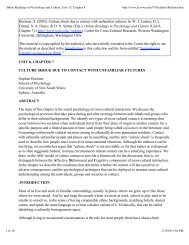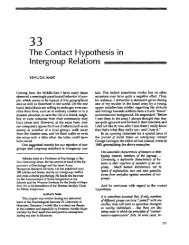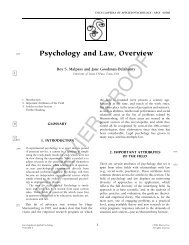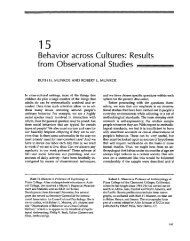From the Lab to the Police Station - Eyewitness Identification Lab ...
From the Lab to the Police Station - Eyewitness Identification Lab ...
From the Lab to the Police Station - Eyewitness Identification Lab ...
You also want an ePaper? Increase the reach of your titles
YUMPU automatically turns print PDFs into web optimized ePapers that Google loves.
"hits," instances in which an eyewitness has identified <strong>the</strong><br />
suspect in <strong>the</strong> case. <strong>Eyewitness</strong>es who identify fillers commonly<br />
are not a part of <strong>the</strong> evidence considered relevant<br />
enough <strong>to</strong> turn over <strong>to</strong> prosecu<strong>to</strong>rs, and of course such<br />
witnesses are almost never called by <strong>the</strong> prosecution. Consequently,<br />
prosecu<strong>to</strong>rs rarely observe eyewitnesses confidently<br />
identify a known-innocent filler, whereas this is a<br />
relatively common event for police <strong>to</strong> observe.<br />
At a more fundamental level, friction between <strong>the</strong><br />
prosecu<strong>to</strong>rs and <strong>the</strong> eyewitness researchers undoubtedly<br />
stemmed at least in part from <strong>the</strong> opposing roles that <strong>the</strong>y<br />
have played in <strong>the</strong> courtroom over <strong>the</strong> past two decades.<br />
Defense lawyers are <strong>the</strong> primary users of eyewitness researchers,<br />
and prosecu<strong>to</strong>rs routinely argue against <strong>the</strong> admissibility<br />
of eyewitness experts. When eyewitness experts<br />
do testify, prosecu<strong>to</strong>rs do everything possible <strong>to</strong> discredit<br />
<strong>the</strong> research or argue against its applicability. Understandably,<br />
many prosecu<strong>to</strong>rs perceive eyewitness researchers as<br />
<strong>to</strong>ols for <strong>the</strong> defense. All in all, prosecu<strong>to</strong>rs felt that <strong>the</strong>y<br />
had <strong>the</strong> most <strong>to</strong> lose from agreeing with <strong>the</strong> researchers'<br />
ideas.<br />
The Product<br />
The final product was about 8,000 words, was published as<br />
a booklet, and is available at no cost from <strong>the</strong> U.S. Department<br />
of Justice, Office of Justice Programs, 810 Seventh<br />
Street, NW, Washing<strong>to</strong>n, DC 20531 ; <strong>the</strong> document can also<br />
be downloaded at <strong>the</strong> Internet address http://www.ojp.<br />
usdoj.gov/nij/pubs-sum/178240.htm. It is not our intent <strong>to</strong><br />
reprint <strong>the</strong> Guide in this article. There are, however, some<br />
portions that deserve special mention.<br />
For example, material in <strong>the</strong> introduction <strong>to</strong> <strong>the</strong> Guide<br />
acknowledges <strong>the</strong> justice system's recognition of <strong>the</strong> usefulness<br />
of <strong>the</strong> psychological literature on eyewitnesses. In<br />
<strong>the</strong> message from U.S. At<strong>to</strong>rney General Janet Reno at <strong>the</strong><br />
beginning of <strong>the</strong> Guide, for instance, she refers <strong>to</strong> "a<br />
growing body of research in <strong>the</strong> field of eyewitness identification"<br />
(p. iii). The introduction states, "During <strong>the</strong> past<br />
20 years research psychologists have produced a substantial<br />
body of findings regarding eyewitness evidence. These<br />
findings now offer <strong>the</strong> legal system a valuable body of<br />
empirical knowledge in <strong>the</strong> area of eyewitness evidence"<br />
(p. 1). We believe that <strong>the</strong>se statements are representative<br />
of <strong>the</strong> growing view within <strong>the</strong> justice system that research<br />
findings by psychologists on eyewitness memory are important<br />
<strong>to</strong> understanding, predicting, and controlling eyewitness<br />
error. The introduction <strong>to</strong> <strong>the</strong> Guide goes on <strong>to</strong> say,<br />
This Guide makes use of psychological findings, ei<strong>the</strong>r by including<br />
<strong>the</strong>m in <strong>the</strong> procedures <strong>the</strong>mselves or by using <strong>the</strong>m <strong>to</strong> point<br />
<strong>the</strong> way <strong>to</strong> <strong>the</strong> design and development of fur<strong>the</strong>r improvements<br />
in procedures and practices for possible inclusion in future<br />
amendments <strong>to</strong> or revisions of this document. (pp. 1-2)<br />
This statement acknowledges that <strong>the</strong> scientific study of<br />
eyewitness memory is a continuing process and that <strong>the</strong><br />
Guide should be revised in <strong>the</strong> future on <strong>the</strong> basis of <strong>the</strong><br />
continuing knowledge generated by research. It is, we<br />
believe, an invitation for researchers <strong>to</strong> contribute additional<br />
research-based solutions <strong>to</strong> <strong>the</strong> practical problems<br />
associated with eyewitness memory. The Guide includes a<br />
bibliography directing readers <strong>to</strong> significant articles and<br />
book chapters in <strong>the</strong> eyewitness literature.<br />
There are many major features of <strong>the</strong> Guide that we<br />
believe are particularly important. In <strong>the</strong> sections of <strong>the</strong><br />
Guide dealing with interviewing eyewitnesses, <strong>the</strong> Guide<br />
calls for (a) establishing rapport; (b) encouraging <strong>the</strong> witness<br />
<strong>to</strong> volunteer information without prompting; (c) asking<br />
open-ended questions, not interrupting <strong>the</strong> eyewitness's<br />
response, and avoid leading questions; and (d) cautioning<br />
<strong>the</strong> witness not <strong>to</strong> guess. In <strong>the</strong> sections on identification,<br />
significant features include (a) guidelines specifying that<br />
only one suspect should be used per lineup procedure, (b)<br />
guidelines regarding how fillers should be selected for<br />
lineups, (c) guidelines for prelineup instructions <strong>to</strong> <strong>the</strong><br />
witness, (d) guidelines for avoiding making suggestions <strong>to</strong><br />
witnesses, and (e) guidelines for conducting <strong>the</strong> sequential<br />
lineup procedure. These features of interviews and of lineups<br />
have been prominent in <strong>the</strong> research literature and<br />
represent much of <strong>the</strong> core of what eyewitness researchers<br />
have been advocating in <strong>the</strong> way of policy. In many cases,<br />
practices have been <strong>the</strong> opposite of <strong>the</strong> research-based<br />
recommendations. We briefly describe each of <strong>the</strong>se features<br />
in terms of how <strong>the</strong>y were manifested in <strong>the</strong> Guide.<br />
Features<br />
Establishing rapport.<br />
Establishing rapport is<br />
appropriate at several phases of <strong>the</strong> investigation, by everyone<br />
from <strong>the</strong> opera<strong>to</strong>r who handles <strong>the</strong> initial 911 call <strong>to</strong><br />
<strong>the</strong> first police officer on <strong>the</strong> scene <strong>to</strong> <strong>the</strong> follow-up investiga<strong>to</strong>r.<br />
Unfortunately, this principle is followed more in<br />
<strong>the</strong>ory than in practice. Many police investiga<strong>to</strong>rs gloss<br />
over this critical phase and jump in<strong>to</strong> <strong>the</strong> informationga<strong>the</strong>ring<br />
phase without having established a personal relation<br />
with <strong>the</strong> victim, not realizing that <strong>the</strong> victim's concerns<br />
may include having someone listen <strong>to</strong> <strong>the</strong>ir plight as<br />
well as solve <strong>the</strong> crime. Not meeting this personal need has<br />
implications for not only <strong>the</strong> effectiveness of <strong>the</strong> interview<br />
but also later in <strong>the</strong> investigation, when eyewitnesses are<br />
expected <strong>to</strong> take even more time from <strong>the</strong>ir schedules <strong>to</strong><br />
give depositions or appear in <strong>the</strong> courtroom. Clearly, eyewitnesses<br />
will be more likely <strong>to</strong> invest <strong>the</strong>ir time and<br />
energy throughout <strong>the</strong> investigation if <strong>the</strong>ir personal needs<br />
are addressed and <strong>the</strong>y are not treated like mere case<br />
numbers who can provide information.<br />
Encouraging <strong>the</strong> witness <strong>to</strong> volunteer information<br />
without prompting. In <strong>the</strong> eyewitness-<br />
interviewer dyad, one person, <strong>the</strong> eyewitness, has extensive<br />
knowledge that <strong>the</strong> o<strong>the</strong>r person, <strong>the</strong> interviewer,<br />
wants. As in any interaction between a knowledgeable<br />
person and a curious person, one would expect <strong>the</strong> knowledgeable<br />
person <strong>to</strong> play <strong>the</strong> dominant role and control <strong>the</strong><br />
flow of information. In real-world interviews of eyewitnesses,<br />
just <strong>the</strong> opposite occurs: The police interviewer<br />
plays <strong>the</strong> dominant role and controls <strong>the</strong> flow of information,<br />
while <strong>the</strong> eyewitness answers questions passively.<br />
Fur<strong>the</strong>r, situational fac<strong>to</strong>rs are rarely conducive <strong>to</strong> a thorough<br />
interview. As a result, eyewitnesses rarely provide<br />
any unsolicited information. This puts an unenviable bur-<br />
592 June 2000 • American Psychologist







